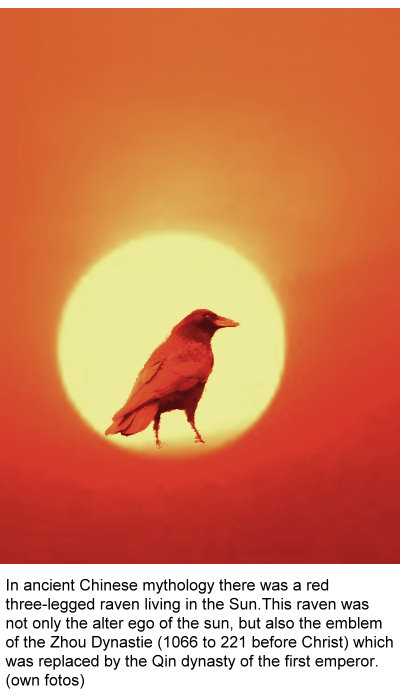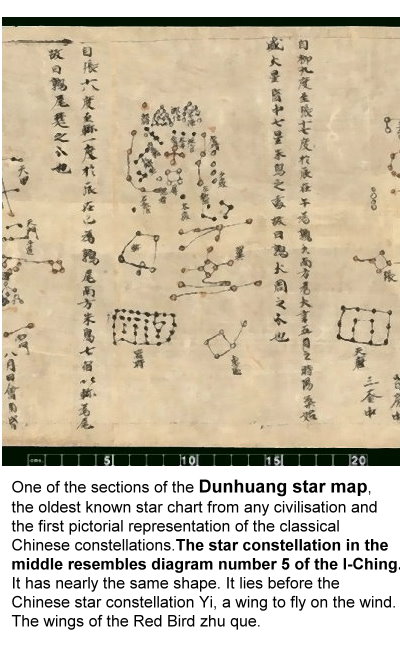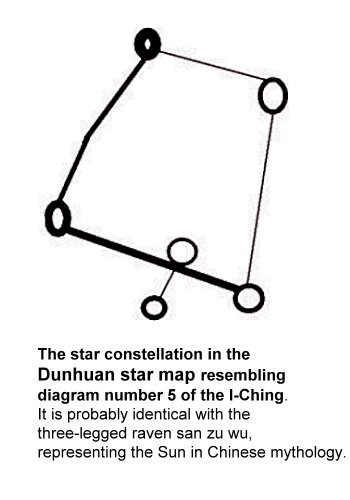Represent the secret images 1 to 12 groups of stars? Are these constellations or asterism not only necessary for timekeeping, but also for getting the support of heaven, when using the I Ching for divination?
Astronomy in China has a long history. The first record of an eclipse of the Sun for example was made in China in 2136 BC. The divisions of the sky began with the Big Dipper (the Plough), also called Northern Dipper, and the 28 lunar mansions. Star names of the 28 mansions have been found on oracle bones, dating back to about 1300 BC. As lunar mansions have such an ancient origin, the meaning of most of their names has become obscure. The meaning of them also could vary at different times in history. Ancient Chinese astronomers divided the sky into three Enclosures, twenty-eight mansions and four mythical animals or Images.
Astronomy was mainly a government activity. The astronomers had to keep track of the solar, lunar and planetary motions and they had divine what astronomical phenomena such as eclipses, comets and the lack or a great number of sunspots may mean for the ruling emperor. The astronomers were responsible for producing the calendar each year, a document known as an almanac. No one else was allowed to calculate a calendar. The calendar was considered to be an important symbol of a dynasty. The I-Ching was as well a book of divination as an almanac we speak of today. Besides Divination the main purposes of astronomical observation was timekeeping. The animals of the four directions are first mentioned in the I Ching, The Book of Changes (Yijing). Here, a map of the heavens, Sifang, shows mythical animals holding court over not only the directions of the earth, but also over the seasons of the year. The mythical animals Azure Dragon, Vermilion Bird, White Tiger and Murky Tortoise are since oldest times associated with the four points of the compass and the four seasons of the year. The constellations which belong to the four animals represent the main stars on or near the ecliptic, the Earth’s orbital plane, throughout the four seasons. They are divided into 28 lunar mansions, i.e. in constellations, the moon goes through in its 28 days.
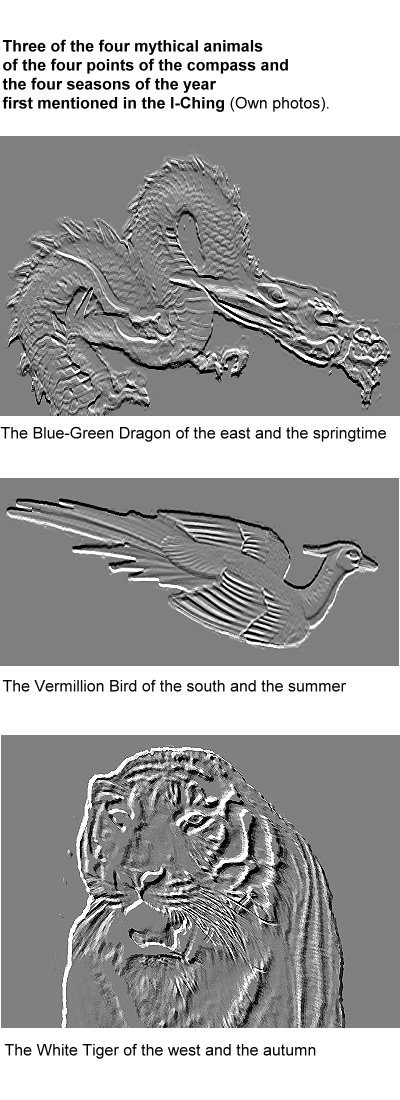
The calendar contained predictions of major events in the sky such as eclipses of the sun and the moon, which affirmed the emperor’s divine link to the heavens. During the long period of observations, astronomers discovered the now so-called Saros cycle.
In this cycle have sun, moon and earth about every 18 years, 11.3 days, the same position to each other. Because of this, solar and lunar eclipses repeat in this period. This enabled the astronomers to predict solar and lunar eclipses with some accuracy.
One of the main purposes of astronomical observation in ancient China was timekeeping. The Chinese used a calendar system based on the phases of the moon (measured through observing the position of the stars in the 28 mansions) and the time of the solar year, or season. They determined seasons and the passage of time through the astronomical phenomena at early evening, lunar mansions in the southern sky and the Big Dipper or Northern Dipper through the pointing direction of its handle. In the winter the „handle“ of the Northern Dipper points north at early evening, in the spring the „handle“ points east at early evening, and so on. Accordingly, ancient Chinese divided the horizon into twelve sections and gave them names for linking the directions to which the „handle“ of Big Dipper points in twelve months.
Because the cycles of the Sun and the Moon are different, intercalation had to be done. A lunar year is eleven days shorter than the solar year because 12 synodic months, or 12 returns of the moon to the new phase, take only 354 days. To make the calendar follow the seasons, in old China the insertion of lacking days and months into some calendar years was done by using calculations of lunar phases.
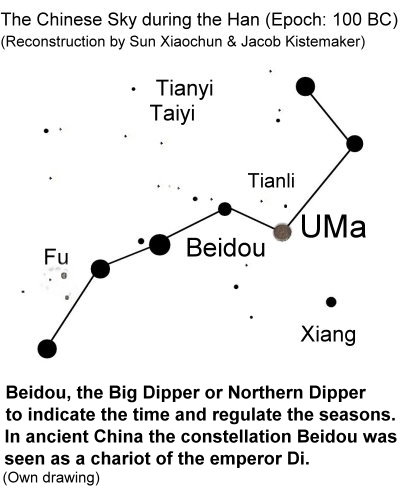
The Chinese constellation Beidou consists of seven stars and is recognized in many cultures as a distinct grouping. In western countries is it named the Big Dipper. As a part of the constellation Ursa Major it is in western countries an asterism. The Big Dipper belongs to the oldest constellations in the sky. In eastern Asia its stars are colloquially named „The Seven Stars of the Northern Dipper”. The Big Dipper indicates with the direction of its „handle“ beginning and ending of seasons. Therefore “Beidou decides about the calendar”, as Sima Qian wrote before more than 2000 years.
Taoists believe that the goddess Dou Mu is the Mother of the Big Dipper. She is considered a personification of light and dawn. As a savior and healer, she is invoked through visualization. Shi unites with cosmic light and “oneness with cosmic principles”. In qigong the Big Dipper is a reservoir of cosmic qi. Above 40 degrees the light of the seven stars of the Big Dipper falls on earth day and night. Here the Seven Stars sink never under the horizon. In this region the influence of these stars respectively the influence of the souls of these stars on human beings is probably greater than that of those, which are no circumpolar stars.
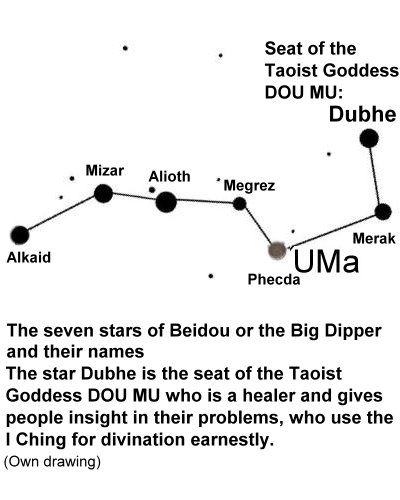
The energies of the hexagrams that build up diagram 12 are the energies of the Taoist Goddess Dou Mu, “the Mother of Beidou”.
Gives Dou Mu people insight in their problems, who use the I Ching for divination earnestly?
The two brightest stars of the Big Dipper are Dubhe and Merak. When the author asks for it, he finds that the seat of the goddess Dou Mu is the star Dubhe. The diagrams 11 and 12 which seem to represent the Big Dipper are build up by the I Ching hexagrams 21, 45, 22 and 46 (diagram 11) and 23, 47, 24 and 48 (diagram 12). Each hexagram has a special energy. The energies of the hexagrams that build up the two diagrams 11 and 12 which represent probably the Big Dipper are energies of spiritual development and healing. In Dou Mu “the Mother of the Big Dipper” in Taoist believe, the author finds especially the energies of the hexagrams 23, 24, 47 and 48 that build up diagram 12. Walter NIesel has assigned the energies of these hexagrams to the following affirmations:
Hexagram 23) BO / SPLITTING APART: I AVOID DESTRUCTIVE FORCES!
Hexagram 24) FU / RETURN: I RENEW THE NATURAL FLOW OF MY LIFE!
(The energies of the hexagrams 23 and 24 are important for healing. The Author finds them in nearly every form of healing. They stand for the solar cycles 23 and 24 at the end of winter, when in the ground already the new life of the coming springtime unfolds.)
Hexagram 47) KUN / OPPRESSION (EXHAUSTION): I OVERCOME DIFFICULTIES BY INERT STRENGTH!
Hexagram 48) JING / THE WELL: I DRINK FROM INEXHAUSTIBLE SOURCES!
These are in fact energies of spiritual development and healing. Hexagram 24) FU / RETURN also includes the energy of divination. With the energies of hexagrams 23 and 24) Dou Mu is a healer, but she probably knows also the Laws of Change and gives people insight in their problems, which use the I Ching for divination earnestly.
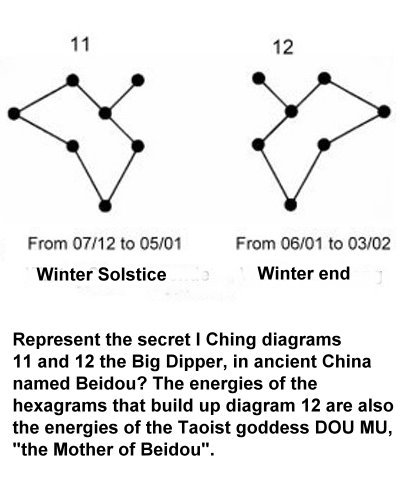
Represent the diagrams 11 and 12 the Big Dipper, in ancient China called Beidou?
The image that is represented by the two graphs 11 and 12, contains seven points – seven is the number of stars of the Big Dipper – and it rotates. Graph 12 is rotated relative to figure 11 to 90 degrees in the counterclockwise sense. The Big Dipper turns as well. It rotates around Polaris. The two graphs 11 and 12 are of a form resembling a car. In ancient China the Big Dipper was regarded as the chariot of the emperor Di. Sima Qian described it as follows: „It serves as a chariot of the emperor Di and controls the four cardinal points of the world by revolving around the center, it divides the yin and the yang and regulates the four seasons, it maintains equilibrium between the five phases, it regulates the moving of the celestial objects, it decides about the epoch of all periodic evolutions and the calendar „.The pointing direction of the handle of the car is north in the winter at early evening, in the spring the „handle“ points east at early evening, and so on. Within a month, the handle rotates 30 degrees in the clockwise sense. The Big Dipper determines so the seasons through the pointing direction of its handle. To know how far the year has progressed, has always been of great importance for agriculture.
How likely is it that the secret pictures 1 to 12 of the I Ching represent star constellations necessary for divination and timekeeping!
It is reported that the I Ching in ancient China was used as a calendar. Like all the calendars in ancient China it was created by astronomers, and was for the rule of a dynasty of great importance. Those for the government working astronomers observed the sky, the moon, the sun and the stars. Their observations could play an important role. Deviations from normal conditions in the sky could be interpreted that the ruler had lost the mandate of heaven. His rule was then threatened. Therefore, these astronomers were not allowed to talk with others. One of their tasks was divination for the government, for which the events in the sky were decisive, e.g. the star constellations, in which appeared a comet. The different star constellations were assigned to specific regions in the kingdom. The abnormal conditions in the sky should show irregularities in the corresponding region. Furthermore, the seasons were determined by the astronomers. Since the lunar year is shorter than the solar year, and because the time of the year contains fractions of a day this was an important and not so easy task. One year must contain whole days. To determine the time of the year, they observed the phases of the moon and the stars, namely the lunar houses, and the direction of the handle of the Northern Dipper at the evening. The sky was thus both an important basis for divination as well as for the determination of the seasons. With such great importance of the sky, it is not surprising that the most important star constellations were taken in a calendar like the I Ching. The probability that the secret graphs 1 to 12 of the I Ching are groups of stars, is therefore quite large.
